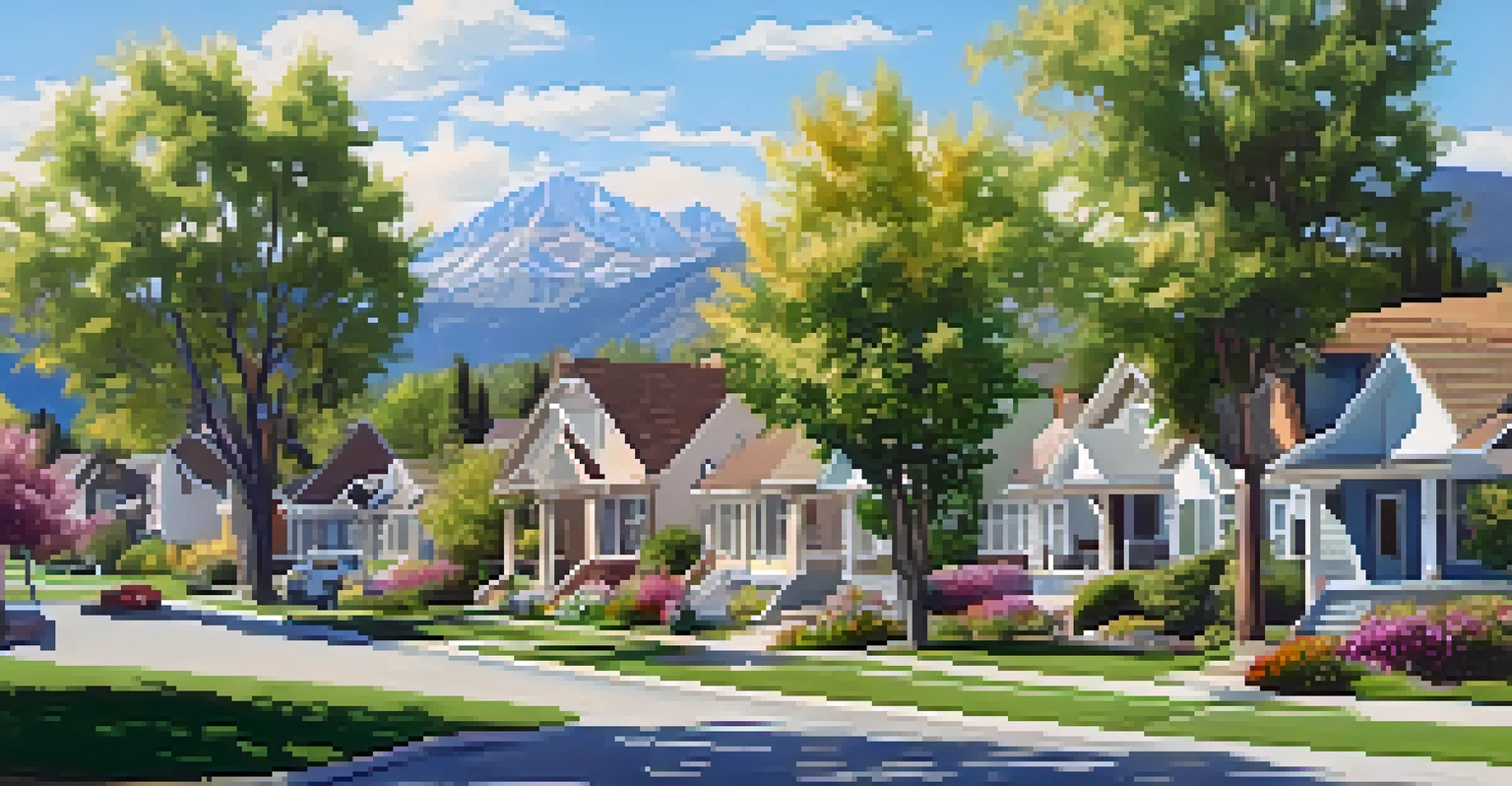Real Estate Trends in Utah: Impact on Local Economy

Overview of Utah's Real Estate Landscape in 2023
Utah's real estate market is experiencing significant changes in 2023, driven by factors like population growth and economic development. With cities like Salt Lake City and Provo booming, these areas are becoming hotspots for both residential and commercial properties. This growth not only reflects the demand for housing but also the influx of businesses and job opportunities, making the state an attractive destination for many.
Real estate is not just about property; it's about people and their dreams.
As more people move to Utah, the demand for housing continues to rise, leading to increased home prices and rental rates. This surge in real estate activity is not just a trend; it's a reflection of the state’s vibrant economy. For example, the tech sector's expansion has brought a wealth of professionals seeking housing, further fueling the market.
Overall, the current real estate landscape in Utah is a blend of opportunity and challenge. While rising prices can be daunting for first-time buyers, the increasing property values also benefit current homeowners and investors. Understanding these dynamics is crucial for anyone looking to navigate the Utah real estate market this year.
Population Growth and Its Effect on Housing Demand
One of the primary drivers of Utah's real estate trends is the state's rapid population growth. According to recent statistics, Utah has one of the highest growth rates in the nation, which significantly impacts housing demand. As more people flock to the state, the need for homes, apartments, and commercial spaces continues to rise.

This growing population often translates into increased competition for available properties, driving prices higher. For example, in areas like Draper and Lehi, bidding wars have become common, making it challenging for buyers to secure homes. This trend not only affects the housing market but also shapes the local economy as more residents means more spending power.
Utah's Population Growth Fuels Demand
The rapid population growth in Utah is significantly increasing the demand for housing, leading to heightened competition and rising prices.
Moreover, the demographic shifts in Utah, including a younger population and diverse family structures, are influencing the types of housing that are in demand. Developers are responding with mixed-use developments that cater to various lifestyles, which in turn supports local businesses and services. This interplay between population growth and real estate development is a key factor in Utah’s economic landscape.
Impact of Remote Work on the Real Estate Market
The rise of remote work has fundamentally changed how people view housing, especially in a state like Utah that offers stunning natural landscapes. Many professionals are no longer tied to their offices, allowing them to seek homes in more affordable or desirable areas. This trend has led to increased interest in suburban and rural properties, which are often more spacious and less expensive than urban counterparts.
The best investment on Earth is earth.
For instance, towns like Park City and Heber City are seeing an influx of buyers looking for second homes or primary residences that offer a better quality of life. This change is reshaping the real estate market, as buyers prioritize features like home offices, outdoor spaces, and proximity to recreational activities.
As remote work continues to be a viable option for many, the demand for diverse housing options will likely persist. This shift is not just altering buyer preferences; it’s also impacting local economies as new residents bring their spending power, driving growth in various sectors, including retail, dining, and recreational services.
Rising Home Prices and Its Economic Implications
With the increasing demand for housing, Utah is experiencing a significant uptick in home prices. This trend raises questions about affordability and accessibility for residents, particularly for first-time buyers. The higher price tags can strain household budgets, pushing some potential buyers out of the market altogether.
However, rising home prices also have a silver lining for current homeowners. As property values increase, homeowners may see their equity grow, which can lead to more spending and investment in the local economy. This boost in equity can also create a stronger market for home renovations and upgrades, further stimulating economic activity.
Remote Work Shifts Housing Preferences
The rise of remote work is transforming buyer preferences, with many seeking homes in suburban and rural areas that offer better quality of life.
The challenge remains for local governments and policymakers to address these rising costs while ensuring that housing remains accessible to all residents. Balancing growth with affordability is essential for maintaining a healthy economic environment in Utah, as it will impact everything from community development to workforce sustainability.
Commercial Real Estate Trends in Utah
While residential real estate often takes the spotlight, commercial real estate in Utah is also undergoing notable changes. The demand for office spaces, retail locations, and industrial properties is shifting due to evolving work patterns and consumer behaviors. For instance, the rise of e-commerce has led to increased demand for warehouses and distribution centers in strategic locations.
In urban centers like Salt Lake City, mixed-use developments are becoming popular, combining residential, commercial, and recreational spaces. This trend not only meets the needs of urban dwellers but also fosters a sense of community, encouraging people to live, work, and play in the same area. Such developments can enhance local economies by attracting new businesses and creating jobs.
As businesses adapt to new realities, the commercial real estate market is poised for innovation. Flexible office spaces and co-working environments are on the rise, catering to the needs of remote and hybrid workers. This adaptability reflects the dynamic nature of Utah's economy and highlights the opportunities for growth in the commercial sector.
The Role of Technology in Utah's Real Estate Market
Technology is revolutionizing the real estate landscape in Utah, making it easier for buyers, sellers, and agents to navigate the market. Online platforms and virtual tours have become essential tools, allowing potential buyers to explore properties from the comfort of their homes. This accessibility is particularly beneficial in a competitive market where time is of the essence.
Moreover, data analytics is playing a key role in understanding market trends and consumer preferences. Real estate professionals are leveraging technology to gain insights into pricing, neighborhood dynamics, and buyer behavior, enabling them to make informed decisions. For instance, understanding which areas are gaining popularity can help investors identify lucrative opportunities.
Tech Innovations Enhance Real Estate
Technology is revolutionizing Utah's real estate market, making property exploration easier and providing valuable insights through data analytics.
As technology continues to evolve, so will its impact on the real estate market. From blockchain for secure transactions to AI-driven tools for market analysis, the future of real estate in Utah looks promising. This technological advancement not only enhances the buying and selling experience but also contributes to the overall efficiency of the local economy.
Future Outlook for Utah's Real Estate Market
Looking ahead, the future of Utah's real estate market appears robust, with several factors contributing to its growth. Continued population influx, job creation, and economic diversification are all expected to drive demand for housing and commercial properties. As the state invests in infrastructure and amenities, it will further enhance its appeal to potential residents and businesses.
However, challenges such as rising home prices and affordability concerns will need to be addressed. Policymakers, developers, and community leaders must collaborate to create solutions that balance growth with the need for affordable housing. This strategic approach will be crucial in maintaining Utah’s status as a desirable place to live and work.

Overall, the real estate trends in Utah not only shape the market but also influence the local economy. By fostering an environment that encourages sustainable growth and development, Utah can position itself for long-term success. As residents and businesses thrive, the state’s economy will continue to flourish, creating a vibrant community for all.